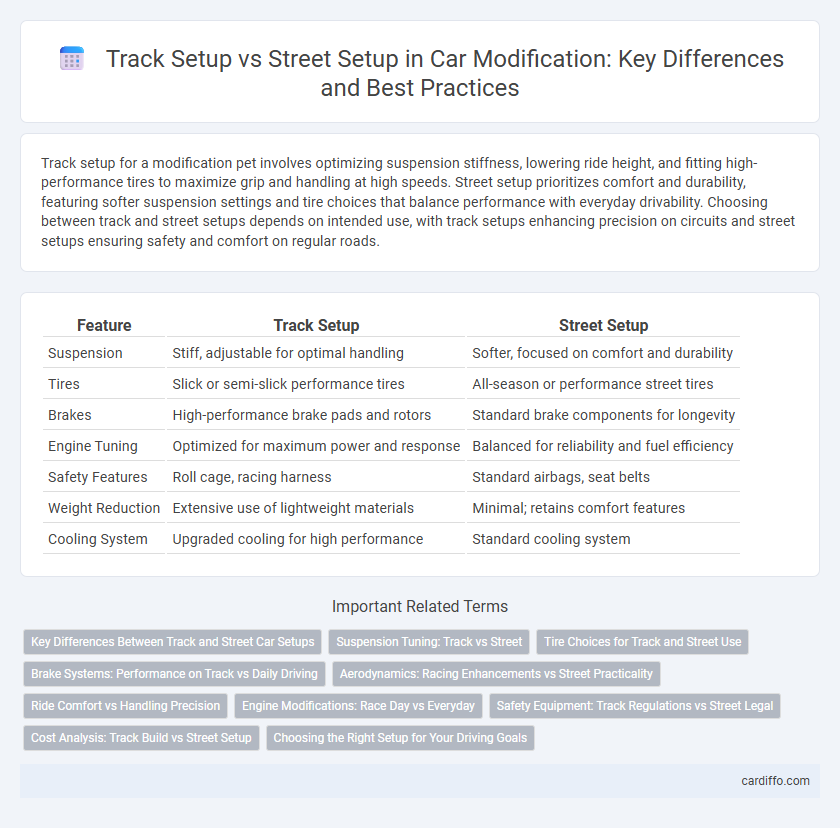Track setup for a modification pet involves optimizing suspension stiffness, lowering ride height, and fitting high-performance tires to maximize grip and handling at high speeds. Street setup prioritizes comfort and durability, featuring softer suspension settings and tire choices that balance performance with everyday drivability. Choosing between track and street setups depends on intended use, with track setups enhancing precision on circuits and street setups ensuring safety and comfort on regular roads.
Table of Comparison
| Feature | Track Setup | Street Setup |
|---|---|---|
| Suspension | Stiff, adjustable for optimal handling | Softer, focused on comfort and durability |
| Tires | Slick or semi-slick performance tires | All-season or performance street tires |
| Brakes | High-performance brake pads and rotors | Standard brake components for longevity |
| Engine Tuning | Optimized for maximum power and response | Balanced for reliability and fuel efficiency |
| Safety Features | Roll cage, racing harness | Standard airbags, seat belts |
| Weight Reduction | Extensive use of lightweight materials | Minimal; retains comfort features |
| Cooling System | Upgraded cooling for high performance | Standard cooling system |
Key Differences Between Track and Street Car Setups
Track car setups prioritize maximum grip and aerodynamic downforce, featuring stiffer suspension components, lower ride height, and more aggressive tire compounds to optimize performance under high-speed cornering and braking. Street car setups focus on comfort, durability, and everyday usability, with softer suspension tuning, higher ride height for road clearance, and tires designed for longevity and wet traction. Key differences include suspension stiffness, tire type, and ride height, directly affecting handling response, ride comfort, and safety in varying conditions.
Suspension Tuning: Track vs Street
Suspension tuning for track setups prioritizes stiffness and precision to maximize handling performance and minimize body roll during high-speed cornering. Street suspension setups emphasize comfort and compliance, absorbing road irregularities for a smoother ride on uneven surfaces. Adjustable dampers and stiffer springs are common in track configurations, while street setups often use softer springs and tuned shocks to enhance daily drivability.
Tire Choices for Track and Street Use
Tire choices significantly impact performance in track and street setups, with track tires designed for maximum grip and heat resistance under high-speed conditions, often using softer compounds that wear quickly. Street tires prioritize durability, comfort, and wet traction, typically featuring harder rubber compounds and tread patterns optimized for varying road surfaces and weather conditions. Selecting the appropriate tire compound and tread design ensures safety and optimal handling tailored to the specific demands of track racing or everyday street driving.
Brake Systems: Performance on Track vs Daily Driving
Brake systems in track setups prioritize high-temperature resistance and consistent pedal feel under extreme conditions, using larger rotors, multi-piston calipers, and racing brake pads to prevent fade during intense laps. Street setups emphasize durability, comfort, and noise reduction, employing smaller rotors, single or dual-piston calipers, and brake pads formulated for low dust and smooth engagement in everyday traffic. Performance brake fluids with higher boiling points and enhanced cooling solutions are critical in track setups to maintain optimal braking efficiency and safety.
Aerodynamics: Racing Enhancements vs Street Practicality
Track setup emphasizes aerodynamics with advanced wings, splitters, and diffusers to maximize downforce and reduce drag, enhancing high-speed stability and cornering performance. Street setup prioritizes practicality by balancing aerodynamic efficiency with everyday driving needs, often featuring smaller spoilers and less aggressive components to maintain comfort and fuel economy. Optimizing aerodynamic elements for race conditions boosts lap times, whereas street setups focus on minimizing wind noise and improving vehicle usability.
Ride Comfort vs Handling Precision
Track setup prioritizes handling precision by stiffening suspension components and lowering ride height, which enhances cornering stability and responsiveness but reduces ride comfort due to increased road harshness. Street setup emphasizes ride comfort with softer suspension and higher ground clearance, smoothing out bumps and vibrations for daily driving ease at the expense of sharp handling. Balancing these setups depends on driver preference and intended use, with the track requiring optimized control and the street favoring comfort over aggressive performance.
Engine Modifications: Race Day vs Everyday
Engine modifications for track setups prioritize maximum power output, including high-performance camshafts, upgraded turbochargers, and enhanced cooling systems to withstand intense stress and heat. Street setups focus on durability and smooth operation, often employing moderate tuning, improved fuel management, and stock-replacement parts to ensure reliability and fuel efficiency during everyday driving. Balancing aggressive components with longevity defines the distinction between race day and daily engine configurations.
Safety Equipment: Track Regulations vs Street Legal
Track setups mandate advanced safety equipment including roll cages, racing harnesses, and fire suppression systems to comply with strict track regulations. Street setups prioritize essential safety gear such as airbags, seat belts, and crash-resistant bumpers to meet legal requirements for public roads. Differences in safety equipment reflect distinct regulatory standards aimed at protecting drivers under varying conditions.
Cost Analysis: Track Build vs Street Setup
Track setups require extensive modifications, including high-performance suspension, upgraded brakes, and lightweight components, leading to significantly higher costs compared to street setups. Street setups prioritize durability and comfort, with standard parts that reduce maintenance expenses and initial investment. The cost difference can exceed 50%, making street setups more economical for daily driving while track builds demand substantial financial commitment for performance gains.
Choosing the Right Setup for Your Driving Goals
Selecting the appropriate setup between track and street is crucial for optimizing vehicle performance and safety. Track setup prioritizes stiff suspension, high grip tires, and precise handling for maximum speed and control under extreme conditions, while street setup favors comfort, durability, and fuel efficiency for everyday driving. Aligning your setup choice with your driving goals ensures improved experience, whether on the circuit or the road.
track setup vs street setup Infographic

 cardiffo.com
cardiffo.com